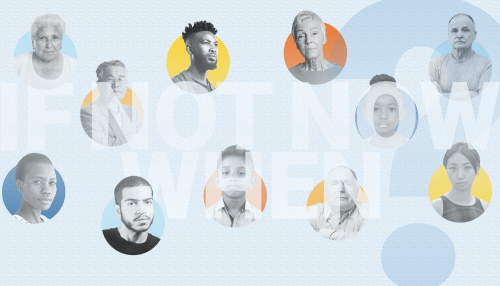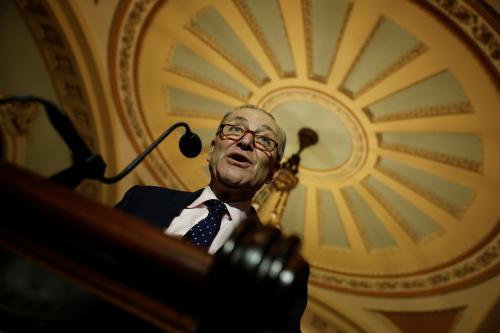Editor’s Note: This brief is part of the Brookings Blueprints for American Renewal & Prosperity project.
The acute economic crisis caused by COVID-19 highlighted the chronic economic problems facing million of Americans. Over the last few decades, middle class incomes, after taxes and benefits, have grown half as fast as those of both the rich and poor. To provide immediate assistance to the middle class, we should eliminate income tax for most middle-class households by raising the standard deduction to $100,000 for a married couple, and provide two years of post-secondary education for free, in exchange for a year of national service. These can be funded by higher taxes on carbon, capital, and consumption.
Challenge
The problem, simply stated, is that the American middle class has experienced much slower income growth than both the affluent (who have seen rising wages) and the poor (who have been helped by an expanded safety net). The household incomes in the middle 60 percent of the distribution have grown only about half as fast as those in the bottom and top 20 percent, once taxes and transfers are taken into account:

When money is tight, it is harder to build wealth. The median middle-class family has $4,500 in liquid wealth and $156,000 of total wealth, compared to $34,800 and $1.1 million for top-quintile families. Wealth inequity is growing even faster than income.
The weakness of income and wealth growth for the middle class reflects the tepid rise in wages, which are the main source of income for middle-class families. Wage growth in the middle and bottom of the earnings distribution has been sluggish in recent decades:

Even as wages picked up among the poor and the well-off in the recovery from the Great Recession, growth rates were much lower for middle-class workers—and that was before COVID-19 cratered the economy. Inequality is not merely a feeling; it is a fact. Importantly, the modest income growth of middle-class families is almost entirely driven by the rise of working hours and especially the wages of women. This is one reason that family policy and economic policy must now go hand in hand.
The transmission mechanism between economic growth and wage growth is breaking down. For decades, the U.S. labor market has failed to deliver enough money to middle-class households. For many middle-class Americans “economic growth has become a spectator sport,” as the economist Jared Bernstein memorably put it.
The cause of the slower growth in wages is a hotly-disputed topic in economic circles. Our view is that a growing imbalance in power relations is the primary culprit, though there is no doubt that productivity plays a part, too. Workers are getting a smaller share of economic output, down to 58 percent from 66 percent in 1960. Just one-in-20 workers in the U.S. private sector are members of a union, down from its high of over one third in the 1950s. These trends have particularly impacted wage growth in the middle of the distribution, as shown above.
Many other factors are also influencing the relationship between work and wages, including automation, especially AI (which may have reduced the contribution of labor to output); trade flows, particularly from China; greater concentration of economic activity in fewer firms; and the geographical clustering of good jobs in certain urban areas, combined with declining worker mobility. It is of course important to attempt to disentangle the varous contributions to slower wage growth, especially to the extent that greater understanding can inform policy. But it is also important not to wait on definitive answers to these complex questions before addressing the problem more immediately.
There is a growing interest in policies that de-link income from employment, most likely in some form of basic income – effectively accepting that the link is being permanently eroded by factors that lie largely beyond the reach of public policy.
But we believe that middle-class prosperity must be based primarily on rewarding work. Americans value work far more than people in many other countries. Work is, of course, a means to an end: more income. But it is more than that. It is also a source of identity, self-respect, connection to others, and sense of purpose. It is also essential to a well-functioning society. The pandemic has revealed how much we depend on the workers who produce our food, deliver packages, care for the elderly, and clean our schools, offices, and hospitals.
Stagnant wages leading to slow income growth for middle class families should be addressed through policies that maintain the connection to work, rather than loosen it; and which address the lack of income directly. We propose two major reforms: eliminating income tax for most of the middle class, and providing two years of free public college.
Limits of historic and existing policies
Of course, it has hardly gone unnoticed that middle-class incomes are falling behind. Arguably, it is the central fact of contemporary politics. But previous policy solutions have fallen short of the challenge, for two main reasons.
First, the focus of policy has been on those at the bottom of the income distribution. This is understandable and justified, but it has meant that little has been done, directly, to help those in the middle of the distribution, where incomes have been rising slowest. Second, many of the policy approaches have leaned too hard on the productivity side of the equation, banking on investments in human capital pulling up wages. But these investments have been inadequate in themselves, and have not provided immediate economic support. Lifelong learning is a great ideal; policy should be transformed, finally, to make it a reality. But we do not have another generation to wait.
We need policies that will tangibly help middle-class families right now.
Policy recommendations
We propose eliminating income tax for most middle-class families by raising the standard deduction — specifically, any married couple making less than $100,000 a year or any single person making less than $50,000. This is an average tax cut of around $1,600 for middle-class families. It would also mean that for most Americans, “April 15 would be just another spring day,” as Columbia law professor, Michael Graetz puts it.
To be clear, this is not because we think taxes are a bad thing. Quite the opposite. Indeed taxes provide the resources for public goods to help those most in need and to invest in the future. And income tax accounts for about half of federal revenue. But some taxes are better than others. The burden should be shared fairly, and beneficial behaviors should be rewarded. A tax on the highest income earners is appropriate because money is increasingly concentrated at the top. Taxing capital, consumption, and carbon is appropriate if the goals are to reward work, promote saving, and protect the environment. Drawing on the work of our Brookings colleagues, especially William Gale and Adele Morris, we propose new or higher taxes on:
- Capital. Capital is lightly taxed in the U.S. compared to earned income. This is backward. Instead of hitting work, we should aim to tax wealth. Unfortunately, direct wealth taxes are tough to administer; it is far simpler to eliminate step-up basis at death and expand the estate tax. These two measures would raise around $135 billion a year. We also favor raising the corporate tax to 25 percent, expensing investment (to encourage growth) and eliminating corporate interest deductions (to put debt and equity financing on a level playing field).
- Consumption. We support a value-added tax (VAT) of 10 percent, about half the average rate in other OECD nations. With a rebate, a VAT would be mildly progressive and still raise around $240 billion a year.
- Carbon. The U.S. response to the climate crisis was weak before 2016; since then, at least at the federal level, it has been nonexistent. The obvious policy move here is a carbon tax, which would marshal market incentives to environmental ends. A carbon tax starting at $25 a ton could raise around $110 billion a year and cut emissions to about a quarter below 2005 levels.
We also propose eliminating many tax deductions—including those for mortgage interest and state and local taxes (SALT), which are highly regressive. They make the whole system unnecessarily complicated, too—and therefore onerous and time consuming for tax filers. A much higher standard deduction would make most of these tax preferences moot for the middle class, who will almost always be better off taking the standard deduction, making the case for entirely eliminating these preferences even stronger. The deduction for business pass-through income should also be eliminated. Not only is it highly regressive, but it creates opportunities for tax avoidance.
In short, we are proposing that the U.S. tax code be reformed and re-founded on clear principles of fiscal prudence and fairness, with the goal of rewarding work and improving the environment, but also meeting the specific needs of the middle class. In addition, a new pro-work policy agenda for the middle class should include the following:
- A $12 per hour federal minimum wage floor, but with higher rates in many areas
- Worker tax credits for the bottom half of wage earners, administered through an offset to their payroll taxes
- Tax incentives for corporations to train their workers and share profits broadly
- Labor law reform and workers’ councils to strengthen employee engagement and bargaining power
- Adequate fiscal and monetary stimulus to create and maintain full employment
We should also reduce one major cost item for middle-class families: college. Middle-class families know their children will need more than a high school education to flourish, but they worry about debt. Critics of free college proposals (including ourselves) point out that since students from affluent families attend the most expensive colleges, progressive-sounding free college proposals often turn out to be regressive in practice.
This argument could be made—and in fact was made, a century ago—against the idea of providing free high school. At some point, Americans decided that a high school education ought to be provided as a public good. In the first half of the 20th century, the average American could ascend to the middle class with a high school diploma, and our education system reflected this reality by making K-12 free. Another criticism is that completion is now a bigger concern than enrollment; this is true, but there are effective programs that provide the support students need to earn a degree or a certificate, which should be expanded.
In today’s economy, a high school diploma is not enough. Post-secondary education or training is now the gateway to the American Dream. We need a free public K-14 education system. But in the spirit of partnership that we believe is the right foundation for policy, we propose that free college or vocational training ought to be conditional on time in the military or civic volunteering.
Specifically, we propose that anybody completing a year of full-time national service, either military or civilian, would be entitled to two years of tuition-free education at any public higher education institution in their home state, including technical and vocational colleges, or at a government-subsidized apprenticeship with an employer. We believe that national service and post-secondary learning should be the norm for every young American.
What would free college or training cost, under our scholarships-for-service plan? It would depend on how many people took up the offer, which colleges they then attended, how many years they attended, and in which states they attended. But for illustration, let’s assume that a third of young Americans perform a year of service and then complete two years of post-secondary training or education. The cost of the free college element would be around $20 billion a year—a much-needed investment in the human capital of our fellow citizens.
It hardly needs saying that there are many other reforms that could put more money on the table of middle-class families. These include help with childcare costs (which we address in our recent volume), stronger retirement options, and affordable health insurance.
Conclusion
Much of our own work and that of our colleagues at Brookings has been on finding ways to improve the lives of all Americans, including those who are poor. Nothing in this document should be read as diminishing the importance of that task. But the economic position of the middle class, especially in such a rich nation as ours, is sufficiently troubling to require bold interventions, like those offered here. A prosperous middle class provides the foundation for a strong society and a healthy democracy.








